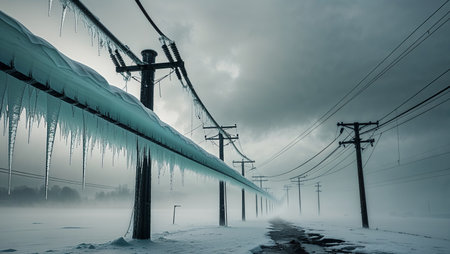Data center concentration can increase risk of winter blackouts — NERC recommends 6 steps for cold-snap preparedness

I live in the “snow belt,” where we average 114 inches of lake-effect snow each year. Ice weights heavy on our power lines, and storms sometimes strain our power grid. That’s why a NERC report about higher winter blackout risks due to data centers caught my eye. In its “2025-2026 Winter Reliability Assessment,” the North American Electric Reliability Corporation found that areas with high net-load hours and very high peak load hours could risk reserve supplies, especially those in which data centers alter the “daily load shape due to their round-the-clock operating pattern.”
An example NERC called out was The Electric Reliability Council of Texas (ERCOT), which manages the flow of electric power to more than 27 million Texas customers. This month, 220 gigawatts of projects have requested connection, 73% of which are data centers. Though NERC acknowledges that after 2021’s Winter Storm Uri, battery storage and demand-response resources were implemented to counter shortfalls, they recommend six preparedness steps to reduce the risks of energy shortfalls. Those recommendations can be found on page 7 of the report, and they apply to other areas with data center density and a chance of cold snaps, such as the Mid-Atlantic, U.S. West, and U.S. Southeast.

Susana Schwartz
Technology Editor
RCRTech
AI Infrastructure Top Stories
RCRTech Rack-to-RAN with ABI Research examines Neoclouds: With infrastructure designed for faster access to GPUs, neoclouds are purpose-built for AI workloads. Smaller and more regional than their hyperscaler brethren, they tend to have simplistic pricing schemes (like GPU-per-hour structures), and rely on open-source software.
Will networks hit a ‘capacity wall’?: Countries will need an average of 2–3 GHz of mid-band spectrum by 2035–2040 to keep pace with surging demand for data, AI-powered services and advanced digital applications, according to new analysis published last week by the GSMA. Ensuring at least 2 GHz of operational mid-band spectrum by 2030 will be a key step to prevent bottlenecks as the 6G cycle begins.
Market Pulse Report: “Private 5G and Generative AI in Industry 4.0” explores real-world examples of 5G-enabled generative AI applications in factories, plants, warehouses, and other industrial venues. See how the combination will bring unprecedented levels of autonomy and real-time decision-making to factories and industrial sites.
AI Today: What You Need to Know
Nvidia’s all-time high triggers stunning investor reversal: Nvidia is fighting off the mat, with investors turning their backs despite a recent earnings report showing a 62% increase in revenue year over year. On Nov. 20, Nvidia plunged 3%, dragging Nasdaq and S&P 500 into sharp declines.
Lunate considers $ 1 billion investment in MGX: Abu Dhabi asset manager Lunate is considering a $1 billion investment to state-backed AI investor MGX. Lunate and the Qatar Investment Authority have invested $1.5 billion into Saudi Arabia’s sovereign wealth fund, which have ties to President Trump’s son-in-law Jared Kushner through his investment firm, Affinity Partners.
Google’s AI infra chief speaks of thousand-fold capacity increase in 5 years: At a recent all-hands meeting, Google’s head of AI infrastructure, Amin Vahdat, told employees the company would need to double AI serving capacity every 6 months in order to meet demand.
In Texas, data centers may increase winter blackout risk: The North American Electric Reliability Corporation warned that data centers’ round-the-clock energy consumption could lead to electricity supply shortfalls if freezing temperatures and extreme winter storms hit Texas, where more than 220 gigawatts of projects have requested connection this month — a 170% increase over the 83 gigawatts of project requests back in January, according to data published Wednesday by ERCOT. About 73% of the projects requesting connection are data centers.
ESPI says Europe should quickly pursue space-based DCs: The European Space Policy Institute (ESPI) is urging Europe to move quickly on space-based data centers, “or risk ceding a potential pillar of future digital infrastructure to global competitors.” In a recent report, ESPI said about 70 million euros ($81 million) of private capital has flowed into space-based data center ventures, or directly relevant enabling components, over the past five years.
Tesla expands AI chips, seeks talent for next-gen designs: Elon Musk said in a social media post yesterday that millions of Tesla’s AI4 chips are powering vehicles and data centers, and that he wants fresh chip design every year. He believes Tesla “could ultimately manufacture chips at higher volumes than all other AI chips combined.” The company has opened direct hiring for silicon engineers.


